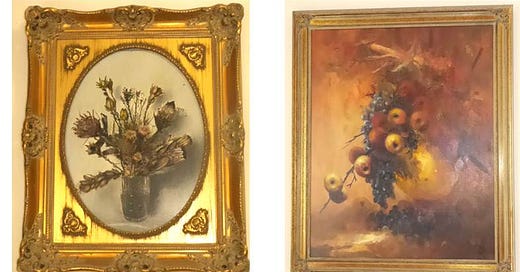Fifty years ago, living in Germany, I got involved in Dutch art. On being relocated when IBM closed my one-man post in Zweibrücken, on the French border, to Frankfurt, I had three months to find an apartment. Putting my fluent German to good use, I wound up taking over the last two years of a five-year lease on one floor of the guest house still owned by the von Meister family, founders of I.G.Farben (now BASF, Hoechst and Bayer). More than a twelve hundred square feet, in only three rooms, with 12-foot ceilings, it was ideal for exhibiting paintings.
A troupe of Dutch artists visited Frankfurt annually to sell paintings to the many military personnel stationed there. But… they needed a host and a venue. Much wine was drunk, good times were had, paintings were sold, and my walls became full. I have never become a connoisseur, but I have been pleased with my taste. Anybody who has seen my videos will recognize some of them from the background.
The art was well-executed in every respect. Some of it a bit impressionistic, like the still life in the upper right above. My criterion for good art is something I could not imagine myself doing.
This same year as my adventures into art, 1975, abstract impressionism – Jackson Pollock and Willem de Kooning – was in the headlines. Tom Wolfe had captured American society very well with The Kandy-Kolored Tangerine-Flake Streamline Baby, The Electric Kool-Aid Acid Test, and Radical Chic & Mau-Mauing the Flak Catchers. When Wolfe’s book explaining modern art, The Painted Word, also appeared that year, I read it with gusto.
On a different thread, I joined the ArtTalkers Toastmasters Club, dedicated to the arts, when I came to Kyiv in 2007. I recently presented a review of “The Painted Word” as a Toastmasters speech. Wolfe’s theme is that what is said and written about art is more significant, affects its value more, than the subject matter or the aesthetic aspects such as color, form, texture, composition and balance.
A follow-up search for which paintings have had the greatest investment value led me to masterworks.com, a company of art experts who pool money from small investors to buy paintings, and some sculpture, that they expect to appreciate in value. Their investment pools typically choose a work of art that costs between a few hundred thousand and ten million dollars, holding it for one to three years before selling. They claim internal rates of return as much as 35% per year.
Predicting taste in art is a tricky business. Their organization has 125 employees, a majority dedicated to selecting, buying and selling works of art. For my own edification, I selected from the Internet one work from each of the artists mentioned in their prospectus, just to satisfy myself as to the validity of Tom Wolfe’s observations.
Many of the artists in whome they invest have obvious stories. Carmen Herrera was a Cuban woman who took up painting at 84 and lived to 106. Japanese artistry has obvious roots in their culture. Haitian and Black American art reflects the artists’ life experiences. I have not read what critics have written about these works, but it is easy to imagine them to be New-Yorker, NY Times-reading urban Americans enamored of diversity, environmentalism and the therapeutic society. It was not shock to find that Masterworks has no investments in George Rockwell, Grant Wood or James McNeill Whistler.
The fifty years since Wolfe’s book will be the topic of another speech, one which will certainly include some of the images of the artists represented among Masterworks’ investments that are in the PDF you can download following the link. They appear to me to be, as much as anything could be, logical projections from the artistic themes and genres of fifty years ago.
I will soon have more to write about art in our lives. An actual artist – Konstantin Rudnev – joined the club this year. Zoriana and I attended his one-man show in the middle of Kyiv last Friday. Zoriana liked one of the paintings, and I have agreed to buy it. Kostya has the kind of story that sells paintings. He was in the furniture business in Mariupol. The Russians bombed it flat. He barely escaped, and he started again from nothing except his thirty-year-dormant skill at painting. The paintings in his show were a graphic display of the maturation of artistic technique. More on this to come.
That’s the news from Lake WeBeGone, where the strong man is giving a speech entitled Investing for Ukrainians tomorrow. The bottom line is that the Ukrainians have so few options that crypto winds up looking pretty good. As the video points out, the same seems to be the case in many other countries. People all over the world like Bitcoin because that’s what they can get. And with all those people wanting it, it might not be that bad. After all, what other than people wanting it accounts for the value of the barbaric relic?




Thanks, Graham. You didn't by chance know Jack Fraley at IBM in Frankfurt?